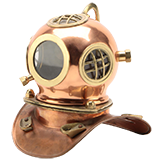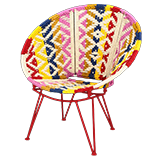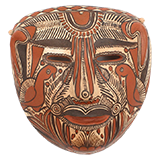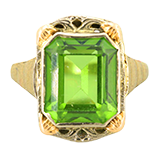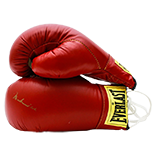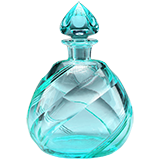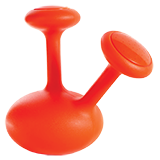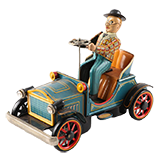William Perehudoff Color Field Acrylic Painting on Deckle Edge Paper
Item Details
WIlliam Perehudoff (Canadian, 1918-2013)
Untitled
acrylic on deckle edge paper
inscribed to the lower right; W. Perehudoff 7/80
unmounted and unframed
22′ × 30′
Provenance
The Lucy Baker and Kenworth Moffett Collection of New New Group Painters
An acrylic painting on paper abstract composition by celebrated Canadian artist William Perehudoff, executed in July of 1980. Carefully laid colors appear stacked in a vertical movement. The half circle form to the top in violet and bottom in emerald are rendered in one clean stroke. Denser fields of brown and orange alternate with a large ground of yellow paint to the center in spontaneous gestures of color.
This painting is influenced by Goethe’s color theory which Perehudoff said inspired him to explore changes in density and reflectiveness with changes in color. As opposed to his paintings of the late 1970’s, the color bars now appear kinetic and free of constraint, no longer relying on shape to define them but instead rely on pure color definition. Perehudoff ’s placement, length, and size of the bars is meditated, preserving a sense of deliberate choice in his purest compositions.
Theory of Colors , 1810, is a book by German writer, Johann Wolfgang von Goethe (1749-1832), about the poet’s views on color and their nature with respect to how they are perceived by people. Goethe describes in detail the play between light and darkness, colored shadows, chromatic aberration and is the first to create a symmetric color wheel in which opposite colors on the wheel emphasize the other. These ideas led Perehudoff to explore how colors varied when applied to different grounds. In the this piece for example, Perehudoff invites the viewer to experience different color tones in the bars as they move across the varied ground. Does the red bar appear darker in areas of shinier ground? Does the dense blue bar appear more defined on a higher ground?
William Perehudoff was born Vasily Vasilevitch Peryegrudov in 1918 in the Canadian city of Saskatoon, Saskatchewan. He was raised 17 miles North of Saskatoon in the Doukhobor community of Bogdanovka near the town of Langham. The Doukhobor colony was a self-reliant farming community where all members of the families were expected to fulfill daily responsibilities of seeding and harvesting crops. William was able to complete grade eleven at the Langham School via correspondence. He continued to work on the farm for much of his early life receiving no formal art training until the late 1940’s. In these early years, Perehudoff made frequent visits to a rural neighborhood to receive some art education and made great use of the Saskatchewan government’s rural library program that allowed him to have books mailed to his home. Recognizing his extraordinary interest and avid use of the program, an administrator for the program began to send Perehudoff the library’s new art books before they were listed to the public. He left the prairies in 1948 to study art at the Colorado Springs Fine Art Center (1948-49) and then onto to New York in 1951 to study at the school of French cubist Amedee Ozenfant (1886-1966).
In 1954, Perehudoff started full time employment as an artist and designer at Modern Press, a printing and publishing company in Saskatoon. He continued to paint and exhibit in Canada, mostly prairie landscape scene and commissioned murals. Perehudoff attended his first Emma Lake Artists’ Workshop in 1957 lead by American artist and figure painter Will Barnet (1911-2012), although his biggest influence would come from the Emma Lake workshops in 1962 and 1963. He had already begun painting abstractly and was committed to modernist ideals and contemporary issues. These workshops would instill newly found ambition and confidence in his work. Clement Greenberg (1909-1994) led the 1962 workshop where he met Perehudoff. Greenberg suggested that he move away from his explorations with abstract expressionism towards more complete non-objective abstraction. The two would continue on to be close friends, exchanging several visits until Greenberg’s death in 1994. A year later, American color field, abstract expressionist and minimalist artist Kenneth Noland (1924-2010) led the 1963 Emma Lake workshop. When Perehudoff met Noland, it was his concern with color that created a common ground between the two. Perehudoff’s greatest discovery was that artists and critics, whom he had great respect for and whose opinions he valued, found his work worth taking seriously.
Emma Lake, Saskatchewan had previously been the site for the Murray Point Art School, a program established in 1936 by prairie painter Augustus Kenderdine for the University of Saskatchewan. The Murray Point Art School was a summer program for the University and was discontinued in 1955. Arthur McKay (1926-2000) and Kenneth Lochhead (1926-2006), professors at the University of Saskatchewan Regina Campus, would first initiate the infamous Emma Lake Artists Workshop. These workshops were meant to bring international artists and critics together and help to minimize the isolation that Saskatchewanian artists felt. The workshops aimed to establish stronger contact with the art world as a whole and to help build momentum for the artwork being produced in Western Canada.
The Emma Lake Artists Workshop has had over eighty artists and critics as leaders over the span of the four decades the workshops were held since the inaugural session in 1955 when Jack Shadbolt (1909-1998) was the leader. The workshops are directly credited with bringing to light the achievements of prairie artists such as Robert Christie (b. 1946), Douglas Bentham (b. 1947), Dorothy Knowles and William Perehudoff. Since Perehudoff and Knowles had a cabin at the lake, he was able to meet and befriend many of the artists over the years forming close relationships with the likes of Clement Greenberg, Kenneth Noland, Jules Olitski (1922-2007)(He did not attend the workshop but Olitski visited his studio in Saskatoon, Saskatchewan), Donald Judd (1928-1994), Friedel Dzubas (1915-994), Anthony Caro (1924-2013) and more.
With many of the leaders being associated with post-war American modernist art, the workshop took on a sort of modern focus. Like these abstract artists of the 1960’s, Perehudoff continued to explore form and color. His concern with color would persist into his later paintings and was often the determining factor in the success of his paintings. Like his contemporary and fellow Canadian color field artist, Jack Bush (1909-1977), Perehudoff did his best to avoid allowing design to over power his work. Despite heavy influence from painters who matured around the same time as he, such as Noland, Olitski, Bush, Dzubas and Poons, Perehudoff developed his own independent thoughts and ideas on color perception. Ideas such as how color and chiaroscuro might be changed or how figure and ground could be fused. Perehudoff’s work evolved continually, and in the early years of the 70’s, he began creating what is considered the first of his mature works. They proved to be consistently more daring and equally more successful. Canadian art curator and writer Terry Fenton (b. 1940) was the first to set critical terms for discussing Perehudoff’s work. Fenton’s introduction to Perehudoff’s solo exhibition at the Edmonton Art Gallery in 1972 describes that Perehudoff’s paintings “possess a maturity that would be rare anywhere in the world,” and that this maturity is rarely self-evident and often “fails to declare its originality in a startling or even obvious way.” Perehudoff’s evolution in the 70’s can be traced through his many series of pieces starting with the Thalia and Arcturus series of 1970 and 1971, then on to Okema and Amyot series of 1975 and eventually the Andante series of the later 1970’s. Perehudoff explored new ranges of color, new kinds of structure and displayed a continued furthering of spontaneity that would ultimately lead to his work in the 80’s, which is often considered some of his best work.
In early part of 1980, Perehudoff began to add a new depth and intensity of expression to his work. His ideas about luminosity and layering as seen in the 1970’s Amyot series persisted but evolved into something new entirely. Famed art historian and critic Karen Wilkin describes this stage of his work best in her piece, William Perehudoff: The Evolution of an Artist, stating, “In his paintings of the 1980s, he [Perehudoff] flirted, like Noland, with iridescence, metallic paints, and chatoyant pigments that changed colour depending on the angle from which they were viewed. Perehudoff’s Apollonian side kept him from such overt flamboyance – or perhaps, it was his rather stern, thrifty, prairie farmer side. Yet paintings such as AC-83-024 (1983) are among his most Dionysian, with their full-throttle exuberance, their dense, richly worked surfaces, their dazzling colour, and their loose, relaxed structures. Thick paint is scraped onto the canvas; almost unconcerned with the existing verticals and horizontals of the canvas, the rhythmic marks seem uninhibited, released from the discipline that informs the finely calibrated canvases of the previous decade, with their classically ordered, parallel ranks of coloured bars. Perehudoff’s gestures, in his paintings of the 1980s, seem more spontaneous than the paintings that preceded them, uncalculated and almost playful.”
Condition
- has been stored rolled up.
Dimensions
Item #
17DCC195-416
















